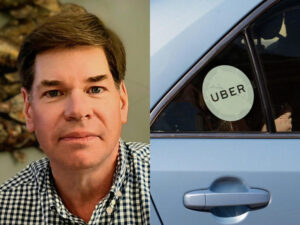SEPTEMBER 29, 2023

Greg Erken. Courtesy of Greg Erken and Robert Alexander/Getty Images
- Greg Erken drives for both Uber and Lyft in Washington, DC, and has given over 12,000 rides.
- He says there are steps both the driver and the passenger can take to improve the experience.
- For starters, make sure your pickup location is accurate, and don’t forget anything in the car.
I’m a ride-hailing driver for Uber and Lyft in Washington, DC. I’ve been driving for almost eight years, and before that, I did everything from lobbying on Capitol Hill to advertising to pizza delivery.
If you do anything 12,000 times, you’ll see strong patterns emerge. The number of interactions I’ve had driving people of every identity has given me a fascinating glimpse into human nature.
I like to hear from my passengers about how ride-hailing is working for them, and I try to help my passengers understand the driver’s perspective so we can both do our part to ensure a smooth and safe trip, from pickup to drop-off.
Here are nine things I wish every passenger knew about issues that your driver faces. (The policies and pay discussed here reflect the Washington market as of September.)
1. A smooth pickup is crucial to this gig
Passengers have a role to play. For starters, the GPS is not magic. Your passenger app first guesstimates where you are, but it may put you on the wrong side of a busy street or be off by several blocks.
Both Uber and Lyft then ask you to confirm your location. To get picked up faster, and help avoid being canceled on, make sure the address you confirm is accurate, or type in a nearby address you can walk to.
Also, please be prepared to answer if I call or text you in the app. I’m trying to find you.
2. Don’t expect to be picked up on the corner of a busy intersection
Stopping there blocks traffic, and I could get rear-ended. Other cars may pull risky moves to get around me.
When you’re at a busy intersection, or in a crowd of people leaving an event or a bustling bar scene, try walking a block or two away, then set your location.
It will be much easier for us to find each other. Plus, you may save money by moving out of a surge zone.
3. Remember we make only pennies while we’re waiting
When I reach your pickup location, after waiting a few minutes, Uber starts paying me a whopping $0.26 a minute. Lyft pays even less in my market.
Likewise, if somebody wants to go through the drive-thru or stop for a pack of smokes, for every five minutes I wait, I make about $1.30 extra. Drivers get paid more based on trip distance, not duration, so we need to keep the car moving.
Well over half my passengers usually make me wait at the pickup. As a matter of courtesy, please be ready when you call your car.
4. Please don’t eat in my car
When a passenger eats during the ride, there’s almost always a mess from crumbs, gum wrappers, or spilled coffee or soda. We don’t have time between rides to clean up, nor should we be expected to.
Some people leave trash. Just the other day, I noticed a rider was flossing his teeth in my backseat, and he just threw the filthy floss pick on the floor of my car.
I drive a lot at night, and I often don’t see a stain or trash until the next morning. Please eat your slice of pizza before I arrive or wait on that McDonald’s until I’ve dropped you off.
5. Pay attention to the dismount
There are a couple of precautions that must be taken when dropping off on busy streets. I discovered early on that passengers would sometimes open the door and step out into oncoming traffic, or even start to get out while the car was still moving.
I quickly learned to keep all my doors locked until it’s safe for my passengers to get out. If necessary, I direct them to exit curbside.
6. You get rated, too
It’s easy for both drivers and passengers to get consistently high ratings. Drivers need to be courteous and professional, drive safely, and have a clean car.
If passengers are polite and not high maintenance, they’ll always get five stars from me. I usually won’t accept a ride request from a passenger rated below 4.7 stars.
Most passengers give drivers five stars, or they don’t rate us (Lyft defaults to five stars). Because of the way the numbers work, an occasional bad rating doesn’t hurt me. Right now, on Uber I’m rated 4.96, and a one-star rating might knock me down to something like 4.95.
7. Yes, we know if you tip
When your ride ends, the app generates an itemized record of our trip earnings, including the fare, any bonuses, and a tip if there is one. If you tip me tomorrow, or two weeks from now, I can see the updated ride receipt. I rarely get cash tips — maybe about $10 a month.
I’ve noticed people who say, “I’ll tip you in the app,” almost never do. And it’s not just me — I’ve seen this complaint for years in online driver forums. People who tip don’t announce it — they just tip. Those that loudly announce it — maybe they’re trying to get five stars from me (if so, they’re trying way too hard).
This is one way in which Uber differs from Lyft. Uber requires the driver to rate the passenger as soon as we end the trip, before we know whether you’ve tipped, and we can’t change your rating later. Lyft gives me 24 hours to change how I rate you.
8. Take all your belongings with you
If you leave something in my car, the $20 return fee that you get charged, and I collect, is usually not enough to cover the time, mileage, and income I lose while returning your belongings.
The most common important things left behind are phones and keys. Passengers haven’t contacted me about trivial stuff left behind such as lipstick or vapes.
In my experience, most people who do leave stuff in my car don’t tip when I’ve returned it. I’ve all but eliminated this problem by always saying at drop-off, “Thanks, folks, have a good night, and make sure you have your phones.”
9. I don’t have an app preference
I’ve been asked whether I like Uber or Lyft better hundreds of times, and my short answer is whichever one is paying me more.
A longer answer involves the fluctuating bonuses these companies use as incentives to increase the supply of drivers to meet demand. But since these bonuses can come and go with the wind, my allegiance to Uber vs. Lyft tends to be equally fickle.
I drive five to seven days a week, and lately, I’ve been driving more for Lyft because the bonuses have been better.
Many passengers have also learned to treat the competing apps like commodities and choose based on price and/or pickup time, rather than the ride-hailing brand.










































































































